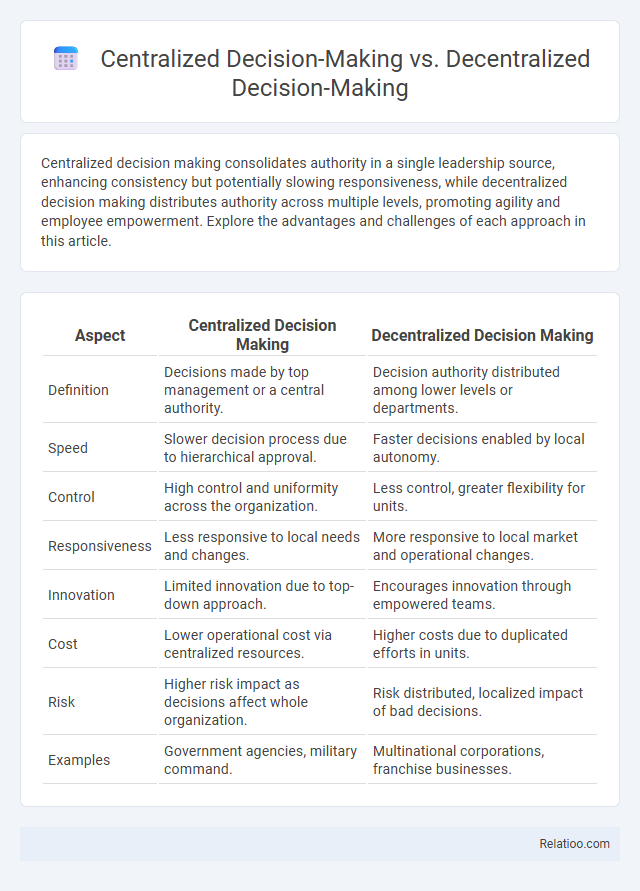Centralized decision making consolidates authority in a single leadership source, enhancing consistency but potentially slowing responsiveness, while decentralized decision making distributes authority across multiple levels, promoting agility and employee empowerment. Explore the advantages and challenges of each approach in this article.
Table of Comparison
| Aspect | Centralized Decision Making | Decentralized Decision Making |
|---|---|---|
| Definition | Decisions made by top management or a central authority. | Decision authority distributed among lower levels or departments. |
| Speed | Slower decision process due to hierarchical approval. | Faster decisions enabled by local autonomy. |
| Control | High control and uniformity across the organization. | Less control, greater flexibility for units. |
| Responsiveness | Less responsive to local needs and changes. | More responsive to local market and operational changes. |
| Innovation | Limited innovation due to top-down approach. | Encourages innovation through empowered teams. |
| Cost | Lower operational cost via centralized resources. | Higher costs due to duplicated efforts in units. |
| Risk | Higher risk impact as decisions affect whole organization. | Risk distributed, localized impact of bad decisions. |
| Examples | Government agencies, military command. | Multinational corporations, franchise businesses. |
Introduction to Decision-Making Structures
Centralized decision-making consolidates authority within a single or small group of leaders, streamlining processes and ensuring uniformity across the organization. In contrast, decentralized decision-making distributes authority to various departments or teams, promoting agility and empowering Your workforce to make context-specific choices. Understanding these structures is critical for aligning organizational strategy with operational efficiency and responsiveness in dynamic markets.
Defining Centralized Decision Making
Centralized decision making refers to a structure where key decisions are made by top management or a single authority within an organization, ensuring uniformity and control. This approach streamlines processes by consolidating power and responsibility, which can enhance consistency but may reduce flexibility and responsiveness at lower levels. Your organization's strategic success depends on balancing centralized control with decentralized autonomy to optimize efficiency and innovation.
Understanding Decentralized Decision Making
Decentralized decision making empowers individual units or employees within an organization to make choices independently, fostering agility and faster responses to market changes compared to centralized systems where decisions are made by top management. This approach enhances innovation and local adaptability, allowing Your teams to tailor strategies based on real-time data and specific operational contexts. Understanding the balance between decentralized decision making and overarching strategy is critical for optimizing business performance and maintaining coherent organizational goals.
Key Differences Between Centralized and Decentralized Models
Centralized decision making consolidates authority within a single point, enhancing uniformity and control but potentially slowing responsiveness. Decentralized decision making distributes authority across multiple levels, promoting agility and local adaptability while risking inconsistency. Your strategic choice between these models impacts organizational efficiency, innovation, and alignment with long-term goals.
Advantages of Centralized Decision Making
Centralized decision making enhances organizational control by consolidating authority, ensuring consistent strategic direction and faster implementation of policies. Your business benefits from streamlined communication and reduced risk of conflicting decisions, leading to increased operational efficiency. This approach also simplifies accountability and aligns decisions closely with overall company objectives.
Benefits of Decentralized Decision Making
Decentralized decision making empowers individual units within an organization to make choices independently, enhancing flexibility and responsiveness in dynamic markets. This approach fosters innovation by leveraging localized knowledge and accelerates decision speed, reducing bottlenecks often seen in centralized systems. Companies utilizing decentralized strategies experience improved employee engagement and adaptability, which are critical for sustaining competitive advantage in complex environments.
Challenges Faced by Centralized Organizations
Centralized decision making in organizations often faces challenges such as slower response times due to hierarchical approval processes and limited flexibility in adapting to local market conditions. This rigidity can hinder innovation and employee empowerment, resulting in reduced motivation and slower problem-solving. In contrast, decentralized organizations distribute authority, allowing for quicker decisions and greater adaptability, but may struggle with consistency and control across departments.
Common Issues in Decentralized Systems
Decentralized decision making often faces challenges such as inconsistent strategic alignment, slower response times due to varied authority levels, and difficulties in maintaining control over dispersed units. Common issues also include communication breakdowns, duplication of efforts, and conflicts between local autonomy and overall corporate objectives. These problems can undermine organizational coherence and lead to inefficiencies compared to centralized decision-making structures.
Ideal Scenarios for Each Decision-Making Approach
Centralized decision making is ideal in scenarios requiring uniformity, quick execution, and controlled environments such as military operations or crisis management. Decentralized decision making excels in dynamic, complex industries like technology or multinational corporations, where local managers have better context for rapid innovation and responsiveness. Strategy alignment occurs when organizations match decision-making structures to operational needs, leveraging centralized control for consistency and decentralized autonomy for adaptability.
Choosing the Right Structure for Your Organization
Choosing the right decision-making structure depends on organizational size, complexity, and agility requirements. Centralized decision making enhances consistency and control by consolidating authority among top executives, ideal for stable environments with clear hierarchies. Decentralized decision making fosters innovation and responsiveness by empowering middle managers and teams, suitable for dynamic markets requiring rapid adaptation to change.

Infographic: Centralized Decision Making vs Decentralized Decision Making
 relatioo.com
relatioo.com